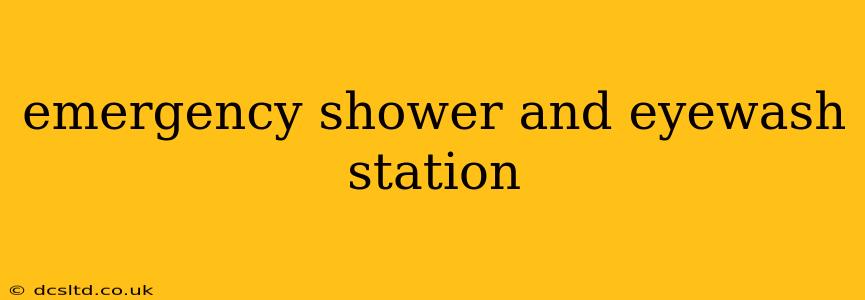Emergency showers and eyewash stations are critical safety equipment found in various workplaces where hazardous materials are handled. These life-saving devices are designed to quickly flush contaminants from the eyes and body, minimizing the potential for serious injury or permanent damage. This comprehensive guide will explore everything you need to know about emergency shower and eyewash stations, covering their purpose, types, regulations, and maintenance.
What is the Purpose of an Emergency Shower and Eyewash Station?
The primary purpose of an emergency shower and eyewash station is to provide immediate first aid in the event of a chemical splash or exposure to hazardous materials. Rapid decontamination is crucial in minimizing the severity of injuries. The shower provides a means to rinse off large areas of the body, while the eyewash station specifically targets the eyes, a particularly vulnerable area. The quicker the contamination is removed, the lower the risk of permanent damage, including blindness or severe chemical burns.
What are the Different Types of Emergency Shower and Eyewash Stations?
Several types of emergency shower and eyewash stations are available, each designed for specific needs and environments.
1. Combination Units: These units combine both an eyewash and a shower in a single station, offering a comprehensive solution for various exposure scenarios. They are often the most common and practical choice.
2. Eyewash Stations Only: These stations are designed solely for eye irrigation and are ideal for situations where a full body shower might be unnecessary or impractical. They are often smaller and easier to install in confined spaces.
3. Drench Showers: These are larger showers designed for full-body decontamination, often used in situations with a higher risk of extensive chemical exposure. They may be standalone units or incorporated into a combination unit.
4. Portable Units: These are smaller, more mobile units that can be easily moved and positioned as needed, useful for temporary applications or situations where fixed installations are impossible.
How Often Should an Emergency Shower and Eyewash Station Be Inspected?
Regular inspection and maintenance are vital to ensure the emergency shower and eyewash station remains functional and ready for use in an emergency. Regulations often dictate the frequency of inspections, but a good rule of thumb is to perform a weekly inspection and a monthly more thorough inspection. These inspections should check for:
- Water flow: Ensure sufficient water pressure and flow.
- Nozzle function: Verify that nozzles are free from obstructions and spray correctly.
- Leaks: Inspect for any leaks in the plumbing or connections.
- Hose condition: Check for damage, cracks, or deterioration in the hoses.
- Cleanliness: The unit should be clean and free of debris.
How Do I Maintain an Emergency Shower and Eyewash Station?
Maintenance is more than just a visual inspection. It includes:
- Regular Flushing: Flush the system for several minutes weekly to prevent stagnation and ensure water clarity.
- Cleaning: Clean the showerhead, eyewash nozzles, and surrounding areas regularly to remove any debris or contaminants.
- Professional Service: Schedule regular professional servicing, typically annually, to ensure proper functioning and address any potential issues.
What are the Regulations for Emergency Shower and Eyewash Stations?
Regulations regarding emergency shower and eyewash stations vary by location and industry. Compliance with relevant OSHA (Occupational Safety and Health Administration) standards or equivalent local regulations is crucial. These regulations often specify placement requirements, water pressure, and flow rate. It's essential to consult the applicable regulations for your specific industry and location.
Where Should Emergency Shower and Eyewash Stations Be Located?
The location of emergency shower and eyewash stations is critical for effectiveness. They should be:
- Easily accessible: Within a reasonable distance of any potential hazard.
- Clearly visible: Marked with appropriate signage.
- Free from obstructions: The path to the station should be clear and unobstructed.
- In a well-lit area: For easy identification and use in low-light conditions.
What are the Common Problems with Emergency Shower and Eyewash Stations?
Common issues include:
- Low water pressure: Can be due to insufficient water supply or clogged nozzles.
- Clogged nozzles: Debris can restrict water flow, reducing the effectiveness of the station.
- Leaks: Can indicate damage to the plumbing or connections.
- Hose damage: Damaged hoses can prevent proper water flow.
Regular inspection and maintenance significantly minimize the risk of these problems. Remember, a properly functioning emergency shower and eyewash station is a crucial aspect of workplace safety, and proactive maintenance is essential to ensuring it can save lives in an emergency.
